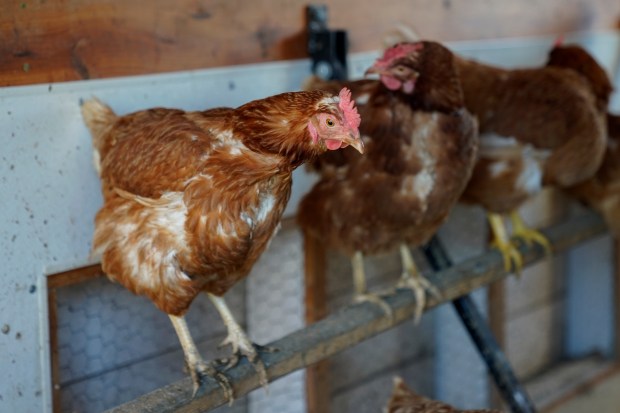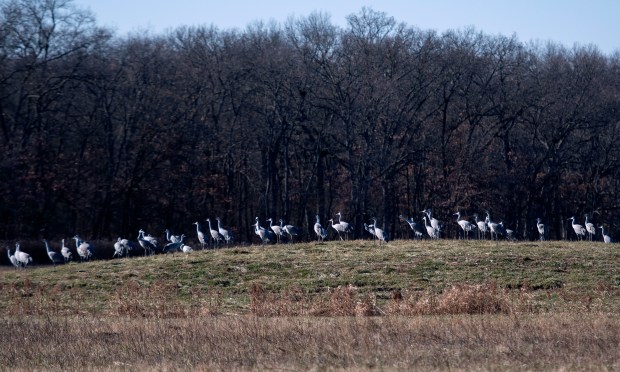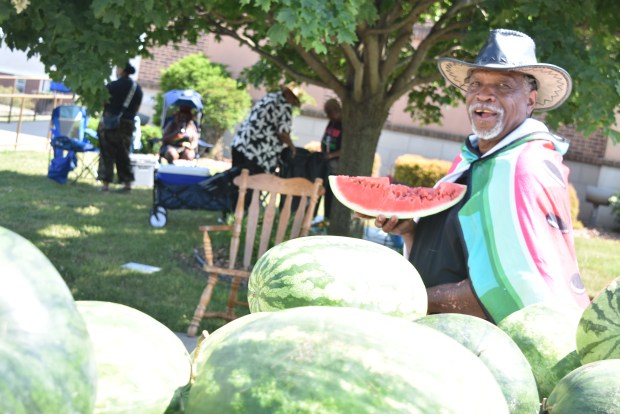About 30 years ago, Carolyn Marsh began bird watching. In the time since then, the Whiting resident has become protective of the local ecosystem.
Because of that, Marsh became worried when she saw an increase in bird carcasses along the lakefront. She noticed most were red-breasted mergansers, a type of diving duck.
“It’s extremely unusual to see dead red-breasted mergansers,” Marsh said. “These are specifically winter migrating ducks. … I’ve never found one dead at all, much less in the huge numbers in the dozens and up to 100.”
Marsh reported the carcasses to the Whiting Parks Department, who then found about 40 birds in the lake’s ice shelf. Eli Fleace, avian health specialist for the Indiana Department of Natural Resources, said the parks department reported the birds to the agency. Dead ducks also have been discovered in the Chicago area, including along the Lake Michigan shoreline.
Since initial reports, the DNR found about 60 carcasses in Whiting, Fleace said. The number is higher than previous years because of the current strain of avian influenza.
Avian influenza, or the bird flu, spreads in birds, cows and other animals, and it can sometimes spread to people, according to the Cleveland Clinic. In the United States, the Centers for Disease Control and Prevention has seen 68 total reported human cases and one death.
Gov. Mike Braun said in a statement Thursday that the state government is monitoring avian influenza in Indiana. Multiple state agencies, including the Department of Agriculture, Department of Health, Board of Animal Health and DNR are working together.
“The Indiana Department of Agriculture, working with the Board of Animal Health, is engaging with poultry producers, whether large scale or hobby farms, to ensure close communication and cooperation,” Braun’s statement said. “DNR is monitoring the situation as it impacts recreation, hunting and sports. IDOH is responsible for monitoring potential human exposure to the avian flu.”
This year’s strain has been around since 2022, Fleace said, and past years haven’t seen mortality rates as severe.
The DNR didn’t clean up birds on the Whiting lakefront, but they gave park staff advice on carcass removal, including wearing disposable gloves and a mask, and double bagging the dead birds before putting them in the trash.
Red-breasted mergansers aren’t the only birds dying from the flu. Hundreds of sandhill cranes, more than 1,000 snow geese and close to 1,000 Canada geese have died across the state, according to DNR numbers.
Sandhill cranes gather at Jasper-Pulaski Fish and Wildlife Area in Medaryville on Wednesday, November 29, 2023. The Indiana Department of Natural Resources said hundreds of the birds have died from avian influenza across the state. (Michael Gard/Post-Tribune)
“It’s different this year than it has been in past years,” Fleace said. “I’m not surprised to see a large mortality event in the ducks in Lake Michigan, just with how the virus has been behaving so far this influenza season.”
Once spring rolls around and temperatures rise, Fleace said avian influenza cases will begin to taper out.
Birds with the virus will struggle to breathe, have a red mucus coming from their beaks and lose control of their muscular system. Fleace said birds’ heads will shake like they’re having a seizure, and they won’t be able to walk or fly.
There’s no way to prevent or contain the bird flu in wild animals, Fleace said.
“If it’s a year like this year, it’s all across the landscape,” he added. “There are birds dying all over the (nation) and in Canada. These birds pick up a virus, then they fly for miles and miles, and they land in prairie potholes or wetlands, and they can shed the virus there. Then they’ll take off and fly again to a new area and shed the virus there.”
The avian flu is not just seen in wild birds; farm animals have also been affected.
Denise Derrer Spears, public information officer for the Indiana State Board of Animal Health, said the agency has received reports of 10 flocks that have had the bird flu this year. In 2024, they only had reports of two flocks with the virus.
Migratory waterfowl are typically the source of the virus for farm birds, Derrer Spears said. The virus is shed in the wild animals’ droppings, so if they fly over a farm, the birds are leaving behind their virus-laden droppings.
“That’s one of the challenges that farmers face because you really can’t just keep (the virus) out of the environment entirely,” Derrer Spears said.
Birds that suddenly get very quiet or aren’t drinking water should be tested for the flu, she added. Derrer Spears also encourages farmers to check if their birds have a loss of energy and appetite, or if their egg production decreases or the eggs are misshapen.
The Indiana State Board of Animal Health has information for farmers online and can help with veterinary services and testing. The board also works with farmers who have infected flocks to clean up.
Derrer Spears recommends good biosecurity for farmers who are worried about avian influenza, including attempts to seal off barns so wild birds can’t enter. She also recommends handlers change footwear and coveralls, and wash their hands to ensure a disease-free environment.

Bird flu, which required farmers to kill millions of chickens to stop its spread, is what’s causing egg prices to increase so dramatically, not inflation, experts say. (Associated Press file)
People with backyard farm birds should try to replicate that as best as possible.
“Our bird advice is to try to get as much space between your backyard flock and any wild birds,” Derrer Spears said. “If you can fence them in, put a net over the top of their space so that you’re not getting wild birds in the coop, and they’re not coming in and sharing feed with your domestic birds.”
U.S. egg prices hit a record high last month, reaching $4.95 in January, according to the Associated Press. The spike in egg prices was the largest since the country’s last bird flu outbreak and accounted for nearly two-thirds of the increase in food costs in January.
Derrer Spears doesn’t recommend serving uncooked or undercooked poultry and egg products to pets, especially cats. Eggs and poultry in stores are safe for people to eat, she added.
“The food supply is safe, and the avian flu is not a food safety risk,” Derrer Spears said. “The products that are in grocery stores, those are coming from farms that don’t have the disease.”
mwilkins@chicagotribune.com




